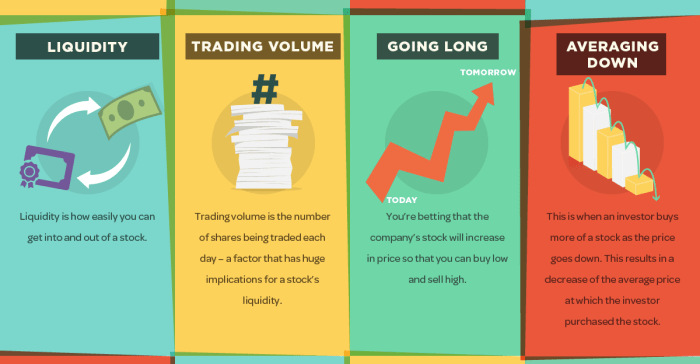As Understanding the stock market takes center stage, this opening passage beckons readers with american high school hip style into a world crafted with good knowledge, ensuring a reading experience that is both absorbing and distinctly original.
Stock markets are like the ultimate game where players make or break fortunes in the blink of an eye. Let’s dive into the dynamic realm of stocks and investments!
Understanding the Stock Market
Investing in the stock market can seem intimidating at first, but it is essentially a marketplace where buyers and sellers come together to trade shares of publicly listed companies. When you buy a stock, you are essentially buying a small piece of ownership in that company.
Role of the Stock Market in the Economy
The stock market plays a crucial role in the economy by providing companies with access to capital to grow and expand their businesses. It also allows individuals to invest in these companies and potentially earn a return on their investment.
- Companies can raise funds by issuing stocks to the public through an Initial Public Offering (IPO).
- Investors can buy and sell stocks, contributing to price discovery and liquidity in the market.
- Stock prices can reflect the overall health of the economy and investor sentiment.
Buy low, sell high – that’s the key to making money in the stock market.
Examples of Stock Market Exchanges Around the World
There are several major stock exchanges around the world where stocks are traded. Some notable examples include:
- New York Stock Exchange (NYSE) – one of the largest stock exchanges in the world, located in the United States.
- NASDAQ – known for its technology and internet-based companies, also based in the United States.
- London Stock Exchange (LSE) – one of the oldest stock exchanges, located in the United Kingdom.
- Tokyo Stock Exchange (TSE) – the largest stock exchange in Japan.
- Shanghai Stock Exchange (SSE) – one of the major stock exchanges in China.
Stock Market Participants
In the stock market, there are several key players who play different roles in the buying and selling of stocks. These participants include investors, traders, brokers, market makers, and analysts.
Investors
Investors are individuals or institutions who buy stocks with the intention of holding them for the long term. They are looking to benefit from capital appreciation and dividends over time. Investors typically conduct thorough research on companies before making investment decisions.
Traders
Traders, on the other hand, are more focused on short-term price movements. They buy and sell stocks frequently to capitalize on market fluctuations. Traders often use technical analysis and trading strategies to make quick profits.
Brokers
Brokers act as intermediaries between buyers and sellers in the stock market. They execute trades on behalf of their clients and provide investment advice. Brokers can be full-service, offering a wide range of services, or discount, providing limited services at a lower cost.
Market Makers
Market makers are individuals or firms that facilitate trading by providing liquidity in the market. They buy and sell securities to ensure that there is a continuous flow of trading. Market makers help maintain an orderly market and narrow bid-ask spreads.
Analysts
Analysts are experts who study companies and industries to provide insights and recommendations to investors. They analyze financial data, market trends, and economic indicators to help investors make informed decisions. Analysts often publish research reports and make stock recommendations.
Stock Market Instruments
Investing in the stock market involves trading various financial instruments that represent ownership in companies or debt obligations. Understanding the types of stock market instruments can help investors diversify their portfolios and manage risk effectively.
Stocks
Stocks, also known as equities, represent ownership in a company and give investors voting rights and a share in the company’s profits. They are considered riskier but offer higher potential returns compared to other instruments.
Bonds
Bonds are debt securities issued by corporations or governments to raise capital. They pay fixed interest over a specified period and are considered less risky than stocks. Bonds are used by investors seeking a stable income stream.
Exchange-Traded Funds (ETFs)
ETFs are investment funds traded on stock exchanges, similar to stocks. They can hold various assets such as stocks, bonds, or commodities and offer diversification benefits to investors. ETFs provide a cost-effective way to access a wide range of assets.
Options
Options give investors the right, but not the obligation, to buy or sell an asset at a predetermined price within a specified time frame. They are used for hedging, speculation, or generating income. Options can be complex and require understanding of market dynamics.
Mutual Funds
Mutual funds pool money from multiple investors to invest in a diversified portfolio of stocks, bonds, or other securities. They are managed by professional fund managers and offer diversification and professional expertise to investors.
Examples of Popular Stock Market Instruments:
- Apple Inc. (AAPL): A popular stock traded on major exchanges like the NASDAQ.
- 10-Year U.S. Treasury Bond: A government bond issued by the U.S. Treasury with a fixed interest rate.
- S&P 500 ETF (SPY): An ETF tracking the performance of the S&P 500 index.
- Call Option on Tesla (TSLA): An option contract giving the holder the right to buy Tesla stock at a specific price.
- Vanguard Total Stock Market Index Fund (VTSMX): A mutual fund tracking the performance of the overall stock market.
Market Analysis and Strategies
When it comes to navigating the stock market, market analysis and strategies play a crucial role in making informed investment decisions. Understanding fundamental and technical analysis, as well as different investment strategies, can help investors identify potential opportunities and manage risks effectively.
Fundamental Analysis
Fundamental analysis involves evaluating a company’s financial health and performance to determine its intrinsic value. This analysis focuses on factors such as earnings, revenue, assets, and liabilities to assess whether a stock is undervalued or overvalued. Investors using fundamental analysis often look at financial statements, economic indicators, and industry trends to make investment decisions.
Technical Analysis
Technical analysis, on the other hand, involves studying past market data, primarily price and volume, to forecast future price movements. This analysis is based on the premise that historical price patterns tend to repeat themselves, and by analyzing charts and indicators, investors can identify trends and patterns to predict potential price changes. Common tools used in technical analysis include moving averages, support and resistance levels, and various chart patterns.
Investment Strategies
- Value Investing: Value investors seek stocks that are trading below their intrinsic value, believing that the market has undervalued them. They focus on companies with strong fundamentals and long-term growth potential.
- Growth Investing: Growth investors target companies that exhibit strong earnings growth potential, even if the stocks may be trading at high valuations. These investors are willing to pay a premium for companies that are expected to grow rapidly in the future.
- Income Investing: Income investors prioritize stocks that pay dividends regularly, aiming to generate a steady stream of income from their investments. These investors focus on companies with stable cash flows and a history of dividend payments.
Market Volatility and Risk Management

Market volatility refers to the rapid and unpredictable changes in the stock market, which can lead to fluctuations in stock prices. This volatility can be caused by various factors such as economic indicators, political events, or even natural disasters. The impact of market volatility on stock prices can be significant, leading to both opportunities and risks for investors.
Impact of Market Volatility on Stock Prices
Market volatility can cause stock prices to fluctuate dramatically within a short period of time. Investors may experience sudden gains or losses depending on the direction of the market. For example, during times of high volatility, stock prices may experience sharp declines due to increased selling pressure. On the other hand, during periods of low volatility, stock prices may remain relatively stable, providing a sense of security for investors.
Importance of Risk Management in Stock Market Investments
Risk management is crucial for investors to protect their investments from the impact of market volatility. By implementing risk management strategies, investors can minimize potential losses and preserve their capital. This includes diversifying their portfolio, setting stop-loss orders, and conducting thorough research before making investment decisions. Additionally, having a clear understanding of their risk tolerance can help investors navigate through uncertain market conditions.
Strategies for Mitigating Risks in the Stock Market
- Diversification: Spreading investments across different asset classes, industries, and regions can help reduce the impact of volatility on a portfolio.
- Stop-Loss Orders: Setting stop-loss orders can help investors limit their losses by automatically selling a stock when it reaches a predetermined price.
- Research and Analysis: Conducting thorough research and analysis before making investment decisions can help investors make informed choices and mitigate risks.
- Long-Term Investing: Adopting a long-term investment strategy can help investors ride out market volatility and reduce the impact of short-term fluctuations on their portfolio.










